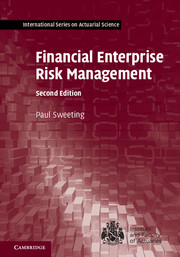Book contents
- Frontmatter
- Contents
- Preface
- 1 An Introduction to Enterprise Risk Management
- 2 Types of Financial Institution
- 3 Stakeholders
- 4 The Internal Environment
- 5 The External Environment
- 6 Process Overview
- 7 Definitions of Risk
- 8 Risk Identification
- 9 Some Useful Statistics
- 10 Statistical Distributions
- 11 Modelling Techniques
- 12 Extreme Value Theory
- 13 Modelling Time Series
- 14 Quantifying Particular Risks
- 15 Risk Assessment
- 16 Responses to Risk
- 17 Continuous Considerations
- 18 Economic Capital
- 19 Risk Frameworks
- 20 Case Studies
- 21 Solutions to Questions
- References
- Index
14 - Quantifying Particular Risks
Published online by Cambridge University Press: 12 August 2017
- Frontmatter
- Contents
- Preface
- 1 An Introduction to Enterprise Risk Management
- 2 Types of Financial Institution
- 3 Stakeholders
- 4 The Internal Environment
- 5 The External Environment
- 6 Process Overview
- 7 Definitions of Risk
- 8 Risk Identification
- 9 Some Useful Statistics
- 10 Statistical Distributions
- 11 Modelling Techniques
- 12 Extreme Value Theory
- 13 Modelling Time Series
- 14 Quantifying Particular Risks
- 15 Risk Assessment
- 16 Responses to Risk
- 17 Continuous Considerations
- 18 Economic Capital
- 19 Risk Frameworks
- 20 Case Studies
- 21 Solutions to Questions
- References
- Index
Summary
Introduction
Many of the approaches described in earlier chapters are used directly to quantify particular types of risk. These applications are described in this chapter, together with some specific extensions that can also be used to determine levels of risk. Since different risks can affect different types of institutions in different ways, several approaches are sometimes needed to deal with a single risk. The links between various risks and the implications for quantification are also discussed.
When quantifying particular risks, it is important that these risks are modelled consistently with each other. In particular, it is important that assets and liabilities are modelled together, so that their evolution can be mapped. This is the basic principle of asset-liability modelling.
As part of this process, it is also important to consider the level of assets and liabilities throughout the projection period, not just at the ultimate time horizon. If the modelling suggests that action should be taken at points within the projection time horizon, then the projection should be re-run taking these actions into account. This is known as dynamic solvency testing or dynamic financial analysis.
Market and Economic Risk
Characteristics of Financial Time Series
Before discussing the way in which market and economic risks can be modelled, it is worth considering some important characteristics of financial time series, particularly in relation to equity investments.
In spite of the assumptions in many models to the contrary, market returns are rarely independent and identically distributed. First, whilst there is little obvious evidence of serial correlation between returns, there is some evidence that returns tend to follow trends over shorter periods and to correct for excessive optimism and pessimism over longer periods. However, the prospect of such serial correlation is enough to encourage trading to neutralise the possibility of arbitrage. In other words, serial correlation does not exist to the extent that it is possible to make money from it – the expected return for an investment for any period is essentially independent from the return in the previous period, and for short periods is close to zero.
Whilst there is no apparent serial correlation in a series of raw returns, there is strong serial correlation in a series of absolute or squared returns: groups of large or small returns in absolute terms tend to occur together. This implies volatility clustering.
- Type
- Chapter
- Information
- Financial Enterprise Risk Management , pp. 326 - 396Publisher: Cambridge University PressPrint publication year: 2017



